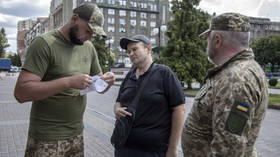Colossal US rocket loaded with classified snooper satellite cargo shot into space (VIDEO)

The world’s largest rocket has successfully blasted into space from Florida’s Cape Canaveral for all to see, but the exact details of its intelligence agency cargo is something that the US government is keeping a closely guarded secret.
The United Launch Alliance (ULA), a joint space delivery service by aerospace giants Lockheed Martin and The Boeing Company, carried out the launch of a Delta IV Heavy rocket on Saturday afternoon.
Tower rolled back. Fueling underway. Counting down to #DeltaIV#NROL37 launch at 1:51pmEDT. https://t.co/RGc8RvwOlkpic.twitter.com/23JhDmad3U
— ULA (@ulalaunch) June 11, 2016
It saw the triple engine craft roar from its launch pad at the Cape Canaveral Air Force Station, traveling at the speed of sound before soaring beyond the atmosphere.
@ulalaunch Tail end of #DeltaIV Heavy from the bleachers of Saturn V Center pic.twitter.com/TVY7JFs1aK
— Janet Kelly Heaton (@jkheaton) June 11, 2016
While much is known about the rocket’s early movements, the Delta IV’s final destination is being kept under wraps.
A statement from ULA is scant on detail, simply explaining that the 32nd Delta IV mission is for the US National Reconnaissance Office (NRO) to support “national defense.”
The NRO is perhaps one of the lesser-known US intelligence agencies, the function of which were only made known to the public back in 1992. The office is largely responsible for producing spy satellites and improving hardware sent out to space.
Go Heavy or Go Home. Today, #NROL37 went Heavy with a @ulalaunch#DeltaIV Heavy launching at 1:51 p.m. pic.twitter.com/IyxFCMWrsf
— NRO (@NatReconOfc) June 11, 2016
“When the United States needs eyes and ears in critical place where no human can reach - be it over the most rugged terrain or through the most hostile territory - it turns to the National Reconnaissance Office,” a mission statement on the NRO website reads.
It is believed that the latest Delta IV rocket launch is again part of that bid to have “eyes and ears” in difficult to reach places, although the exact purpose or location of the satellite is unknown.












